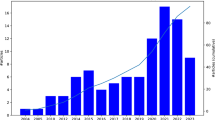Abstract
This paper proposes an aggregated index of acceptability that can establish a “ranking” of the possible candidate hub cities in the design of a telecommunications network. The main advantages of the aggregated index proposed are the following: (a) it takes into account several wide-ranging design criteria, (b) its formulation is given by a lineal mathematical expression, (c) the procedure for calculating the index is very simple, and (d) the candidate hubs can be ranked differently depending on the aggregation structure of the criteria involved. Taking this considerations, the application of the proposed methodology can supplement the information supplied by more sophisticated multicriteria approaches based generally upon 0/1 goal programming. The theory presented is illustrated using a case study taken from the literature.

Similar content being viewed by others
References
Andre FJ, Romero C (2008) Computing compromise solutions: on the connections between compromise programming. Appl Math Comput 195:1–10
Behzadlan M, Otaghsara SK, Yazdani M, Ignatius J (2012) A state of art survey of TOPSIS applications. Expert Syst Appl 39(17):13051–13069
Blasco F, Cuchillo-Ibáñez E, Alonso-Morón M, Romero C (1999) On the monotonicity of the compromise set in multicriteria problems. J Optim Theory Appl 102:69–82
Bu L, Van Duin JHR, Wiegmans B, Luo Z, Yin C (2012) A selection of city distribution locations in urbanized areas. Procedia Soc Behav Sci 39:556–567
Choo EU, Wedley WC (2004) A common framework for deriving preference values from pairwise comparison matrices. Comput Oper Res 31:893–908
Díaz-Balteiro L, Romero C (2004) In search of a natural systems sustainability index. Ecol Econ 49:399–403
Erhgott M, Tenfelde-Podehl D (2003) Computation of Ideal and Nadir values and implications for their use MCDM methods. Eur J Oper Res 151:119–139
Gonzalez-Pachon J, Romero C (2007) Inferring consensus weights from pairwise comparison matrices without suitable properties. Ann Oper Res 154:123–132
González-Pachón J, Romero C (2014) Analysis of pairwise comparison matrices. In: Wiley enciclopedia of operations research and management science, pp 1–9
Havanov N, Kolari J, Sokolov M (2008) Deriving weights from general pairwise comparison matrices. Math Soc Sci 55:205–220
Kawasumi Y, Miyoski Y, Koizumi K (2007) How to provide broadband access for rural and remote areas of developing countries. In: Proceedings of PTC’07, Telecom with vision. Honolulu, Hawaii
Lee H, Shi Y, Stolen J (1994) Allocating data files over a wide area network: goal setting a compromise design. Inf Manag 26:85–93
Lee H, Shi Y, Nazem S (1996) Supporting rural telecommunications: a compromise solution approach. Ann Oper Res 68:33–45
Lee H, Shi Y, Nazem S, Kang SY, Park TH, Sohn MH (2001) Multicriteria hub decision making for rural telecommunications networks. Eur J Oper Res 133:483–495
Lin C (2007) A revised framework for deriving preferences values from pairwise matrices. Eur J Oper Res 176:1145–1150
Nacem S, Shi Y, Lee H, Sung Yeol K, Tae Ho P, Myung S (2001) Multicriteria hub decision making for rural area telecommunication networks. Eur J Oper Res 133(3):483–495
Nazem S, Liu Y, Shi Y (1994) Designing rural areas telecommunication network via hub cities. Omega 22:305–314
Nazem S, Liu Y, Lee H, Shi Y (1996) Implementing telecommunications infrastructure: a rural America case. Telematics Inform 13:23–31
Romero C, Rehman T (2003) Multiple criteria analysis for agricultural decision, vol 11. Elsevier Science, New York
Romero C (2004) A general structure of achievement function for a goal programming model. European Journal of Operation Resesearch 153:675–686
Roy B, Slowinsk R (2013) Questions guiding the choice of multicriteria decision aiding method. EURO J Decis Process 1:69–97
Saaty TL (1980) Multicriteria decision making: the analytic hierarchy process. McGraw-Hill, New York
Saaty TL (1995) Decision making for leaders: the analytic hierarchy process for decision in a complex world. RWS Publications, Pittsburgh
Saaty TL (2011) Decision making with the analytic network process: economic, political, social and technological applications with benefits opportunities costs and risks. Springer, New York
Saaty TL (2012) Models, methods, concepts and applications of the decision making for analytic hierarchy process. Springer, New York
Steuer RE (1989) Multiple criteria optimization: theory, computation and application. Drieger, Malabar
Vaidya OS, Kumar S (2006) Analytic hierarchy process: an overview of applications. Eur J Oper Res 169:1–29
Yu PL (1973) A Class of solutions for group decision problems. Manag Sci 19:936–946
Zeleny M (1974) A concept of compromise solutions and the method of the displaced ideal. Comput Oper Res 1:479–496
Zeleny M (1998) Multiple criteria decision making: Eight concepts of optimality. Hum Syst Manag 17(2):97–107
Author information
Authors and Affiliations
Corresponding author
Rights and permissions
About this article
Cite this article
Romero, M., Cuadrado, M.L., Romero, L. et al. Optimum acceptability of telecommunications networks: a multi-criteria approach. Oper Res Int J 20, 1899–1911 (2020). https://doi.org/10.1007/s12351-018-0387-0
Received:
Revised:
Accepted:
Published:
Issue Date:
DOI: https://doi.org/10.1007/s12351-018-0387-0




